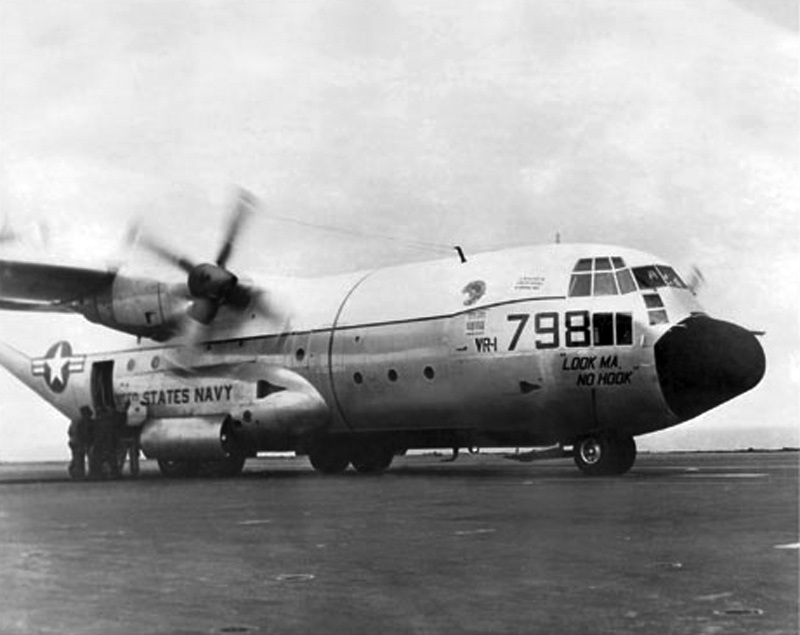The story of the C-130 Hercules that landed on USS Forrestal
Even if, nowadays, the C-2 Greyhound is the biggest transport aircraft designed specifically for carrier operations, on Oct. 30 1963, in an attempt to investigate the possibilities of using the C-130 for logistic support for U.S. fleet, a Hercules made an experimental landing on the aircraft carrier USS Forrestal (CVA-59).
With the successful test, which took place in moderately rough seas in the North Atlantic 500 miles off the coast of Boston, the Hercules became the largest and heaviest aircraft to ever land on an aircraft carrier, a record that stands to this day.
The idea behind this unusual test was the so-called “Super Carrier Onboard Delivery” (Super COD) aircraft.
The COD concept was born to resupply aircraft carriers with urgently needed items. At the beginning of the 1960s, the airplane used for such task was the Grumman C-1 Trader, a twin piston-engine aircraft with a limited payload capacity and 300-mile range, the Chief of Naval Operations ordered to assess the possibility of operating a bigger transport airplane aboard the Norfolk-based USS Forrestal (CVA-59).
As explained by Joseph Earl Dabney in his book Herk: Hero of the Skies the C-130 was selected for its stability and reliability, combined with a long cruising range and the capability of carrying large payloads.
The crew for this historic test consisted of Lt. James H. Flatley III, pilot; Lt. Cmdr. W.W. Stovall, copilot; ADR-1 E.F. Brennan, flight engineer; and Lockheed engineering flight test pilot Ted H. Limmer, Jr.
When Lt. James H. Flatley III was told about his new assignment, he thought somebody was pulling his leg. “Operate a C-130 off an aircraft carrier? Somebody’s got to be kidding,” he said.
According to Dabney a KC-130F refueler transport (BuNo 149798), on loan from the U.S. Marines and delivered on Oct. 8, 1963 was chosen for the historical trial.
Lockheed’s only modifications to the original plane was a smaller nose-landing gear orifice, an improved anti-skid braking system, and removal of the underwing refueling pods. “The big worry was whether we could meet the maximum sink rate of nine feet per second,” Flatley said. But, the Navy was amazed to find they were able to better this mark by a substantial margin.
The initial sea trials started on Oct. 30 1963 and were conducted into a 40-knot wind: however the crew successfully performed 29 touch-and-go landings, 21 unarrested full-stop landings, and 21 unassisted takeoffs at gross weights of 85,000 pounds up to 121,000 pounds.
At 85,000 pounds, the KC-130F came to a complete stop within 267 feet, about twice the aircraft’s wing span as remarked by Dabney on his book.
The Navy discovered that even with a maximum payload, the plane used only 745 feet of flight deck for takeoff and 460 feet for landing. These achievements were confirmed by Lockheed’s Ted Limmer, who checked out fighter pilot Flatley in the C-130 and stayed on for some of the initial touch-and-go and full-stop landings. “The last landing I participated in, we touched down about 150 feet from the end, stopped in 270 feet more and launched from that position, using what was left of the deck. We still had a couple hundred feet left when we lifted off.”
The plane’s wingspan cleared the Forrestal’s flight deck “island” control tower by just under 15 feet as the plane roared down the deck on a specially painted line.
As explained by Dabney, Lockheed’s chief engineer, Art E. Flock was aboard the USS Forrestal to observe the testing. “The sea was pretty big that day. I was up on the captain’s bridge. I watched a man on the ship’s bow as that bow must have gone up and down 30 feet.”
The speed of the ship was increased 10 knots to reduce yaw motion and to reduce wind direction: in this way, when the plane landed, it had a 40 to 50 kts wind on the nose. “That airplane stopped right opposite the captain’s bridge,” recalled Flock. “There was cheering and laughing. There on the side of the fuselage, a big sign had been painted on that said, “LOOK MA, NO HOOK.”
The analysis of data collected by the U.S. Navy during the tests highlighted that the C-130 Hercules could carry 25,000 pounds of freight, fly for 2,500 miles and eventually land on a carrier. However, the procedure was considered a bit too risky for the C-130 and the Navy decided to use a smaller COD aircraft. For his effort, the Navy awarded Flatley the Distinguished Flying Cross.
In the video below you can see the trials conducted by the Hercules on the USS Forrestal and described in the article.
Image credit: U.S. Navy
















